What is happening behind stucco and manufactured stone?
by sadia_badhon | March 12, 2020 10:20 am
by Peter Barrett
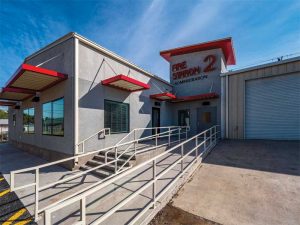 [1]
[1]Stucco and manufactured stone have been employed in the building industry for ages. These claddings are well known for their fire-resistance abilities, durability, and aesthetics. According to Transparency Market Research[2], the value of the global stucco market is expected to reach over $16 million by 2026.
Although stucco is a suitable choice for several reasons, improper installation will lead to one major problem—moisture infiltration. Without the right protection, uncontrolled moisture will lead to mold, wall rot, and decay, and eventually have an impact on both the aesthetics and structural integrity of the building. Although weather protection is a concern for any type of building, professionals using stucco cladding should take greater care to ensure that the buildings are well prepared for the road ahead.
Once viewed as a cladding system with the ability to solve moisture problems, stucco is now seen as causing hidden wall rot. One of the places this first became widely known was in Vancouver, British Columbia, Canada, in the 1990s, when stucco bonded to plastic weather-resistive barriers (WRBs) had rotted oriented strand board[3] (OSB) behind the WRBs. Then the issue moved south and east to places like Minneapolis, Minnesota, and Greensborough, South Carolina. First, it was noticed on multistory, wood-frame buildings because rain exposure increases with height, and then on regular wood-frame low-rises.
In 2018, building expert Joe Lstiburek said construction professionals did not learn from Vancouver, and he predicts an impending ‘stucco-pocalypse[4].’
The industry needs to come together to make buildings better by specifying the right system made up of the suitable products and follow up to ensure proper installation.
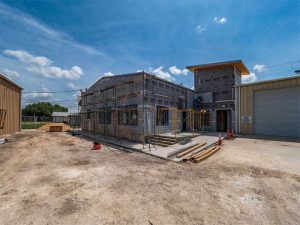 [5]
[5]
Signs of failure
Trapped moisture can cause severe issues that may not be evident until it is too late. For example, the commonly known ‘stucco tear’ stains that appear under installations such as windows are signs of moisture-induced damage to the wall systems.
Other warning signs include:
- dark spots;
- heavy staining;
- odor;
- cracks;
- bulges in the stucco finishes; and
- missing stucco.
Without preventative measures, these issues are likely to have a negative impact on the overall structural integrity and safety of the building.
The problem begins during installation
In the author’s experience, there is not as much energy going across assemblies as there used to be. This is due to increased thermal resistance (i.e. more insulation in the walls). Reduced energy flow limits the drying abilities of wall assemblies when wet. The more efficient the assembly, the lower the drying potential. So, as the drying potential is reduced, so must a wall’s wetting potential.
Stucco is also considered a reservoir cladding, which means it can absorb and store rainwater. Claddings like this can be thought of as ‘moisture capacitors.’ In effect, wetting charges them. It is part of a group of materials such as brick, unpainted wood, and fiber cement that will store water. Claddings like vinyl, aluminum siding, or metal panels would not be considered reservoir claddings[6].
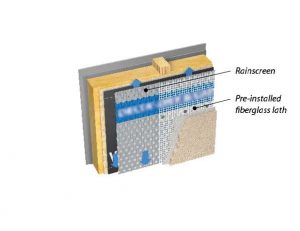 [7]
[7]Further, gypsum sheathing is vapor permeable and OSB sheathing is vapor impermeable.
How is high vapor permeability a problem? When a reservoir cladding discharges inwardly, the inwardly driven vapor can easily pass through the exterior gypsum sheathing and damage the wall cavity and interior finishes.
How is lower vapor permeability a problem? The wall assembly itself cannot dry outward, but, there is an additional issue with OSB. Unlike plywood, when OSB is wetted from the exterior, it is incapable of redistributing moisture within itself. OSB is significantly lower in permeance than plywood. Plywood can pull water into its structure and wick it away from the point of wetting and subsequently release it both inward and outward as it increases in permeance. OSB has none of those properties. With OSB, the moisture redistribution must happen on its surface. Hence, the absolute need for an airspace over its exterior surface.
On top of this, Lstiburek explains the physical characteristics of stucco used in applications have also changed. Over the years, the components have gone from lime-based, lime-Portland cement-based, Portland cement-based, and polymer modified. With each step it has gotten stronger, but also created a less vapor permeable mixture. Today’s stuccos do not breathe as well as the old kinds. These changes have led to very significant problems with stucco, particularly in places where it rains a great deal.
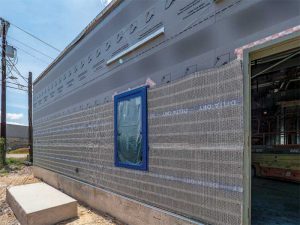 [8]
[8]Building professionals understand it is critical to keep water and dampness from getting into a structure by preventing moisture from moving through the wall from the outside. This is accompanied by putting the right measures in place to keep any moisture from penetrating the system.
The initial solution was to use two layers of WRB—the outer layer would act as a bond break and the inner one would be the ‘true’ dimensionally stable WRB. However, these assemblies had lacked enhanced drainage and drying.
Professionals have since learned the more effective means of accomplishing both is to provide a drainage mat between the bond break and the WRB. Moisture can be fully blocked by uncoupling the stucco from the rest of the wall and installing the stucco over a vented and drained air gap.
Best practices when installing commercial stucco wall assemblies
In a steel stud wall with gypsum sheathing it is very important to install some type of water and air control layer on the exterior of the gypsum sheathing. This layer also needs to be vapor open to allow the wall to dry outward. This layer could be a fluid-applied, fully adhered, vapor-permeable membrane. On it could be sheet product such as a WRB film. Another option would be gypsum sheathing with an integral water control layer with joint treatment. Over this layer goes a drainage mat that resists hydrostatic pressure and prevents inward vapor drive, such as a dimple mat with a mortar screen that allows for air gaps on both the interior and exterior side of the membrane. The stucco layer goes over the mat.
Nothing changes for a steel stud wall with OSB sheathing except when the OSB sheathing may have a fluid-applied or an integral water control layer.
With a drained and ventilated stucco cladding, the wall assembly can dry to the outside into the air gap behind the stucco. With a vapor-closed drainage mat, inward vapor drives through the stucco are completely blocked.
The same approach works behind natural stone claddings and manufactured stone veneers.
Providing a gap between the stucco and the substrates creates an airspace between the cladding and the rest of the wall. This gap provides two important functions—one is to allow outward drying through a vapor-open, water- and air-control layer, and the second is to prevent inward wetting as a result of moisture coming through a reservoir cladding. With the right kind of space, stucco will last hundreds of years.
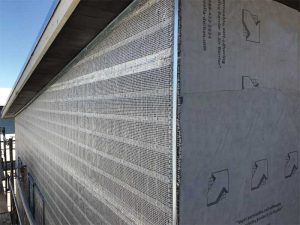 [9]
[9]When it comes to creating the gap, various methods and materials can be used to separate the cladding from the substrates. One of these moisture protection approaches, and arguably perhaps the most effective, is using a dimpled membrane, or ventilated rainscreen. By disconnecting the cladding system, it uncouples it from the rest of the assembly, thereby improving longevity and durability. Without breaking the bond between commonly used housewraps and stucco to provide an air gap, coupled with the use of an alkali cementitious base scratch coat that can help act as a surfactant, stucco cladding systems will continue to fail.
Bringing the concept to life
A fire station is an icon of safety, part of the entire community, and central to everyday life. Recognizing the need to create a building that symbolized these values through design and performance was the driver behind the newly designed and rebuilt Lockhart Fire Rescue Headquarters in Lockhart, Texas. Designed by architect Robert Steinbomer and built by Countywide Builders, the new facility totals 251 m2 (2700 sf).
The exterior of the fire station is made up of stucco cladding, a design element that can be resistant to fire, rot, mold, impact, and termite infestation for as long as 100 years when properly installed. The design required a durable building envelope that could withstand a notoriously hot and humid climate in Texas with a focus on airtightness and vapor permeability.
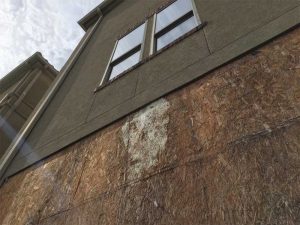 [10]
[10]Photo courtesy Building Science Corporation
To create a high-performance wall system, a two-in-one rainscreen and lath was selected. Located in front of a spun-bonded polypropylene, self-adhering air- and water-resistive barrier, the rainscreen system features a drainage and ventilation layer in one, but also incorporates lath for the first scratch coat of the stucco. Simplifying many steps, the ventilated rainscreen with pre-installed glass lath will help to eliminate the building enclosure’s risk of solar-driven moisture. At the same time, this one-step moisture control and lath system would allows any incidental moisture from within the wall to dry to the outside.
Unlike traditional methods, the fire station’s exterior cladding is efficiently uncoupled from the rest of the assembly, thereby giving it longevity and durability.
Conclusion
When stucco and manufactured stone buildings are built correctly, they can provide many benefits, which include energy efficiency, sustainability, durability, and also increased fire protection. However, when moisture protection is unaddressed, the effects can be detrimental. Getting ahead of water and dampness is the only way to ensure new stucco and manufactured stone buildings give their full potential.
There are products incorporating all these qualities. For example, ventilated rainscreen membranes made of a special high-density polyethylene (HDPE) with pre-installed glass lath are multifunctional and provide high levels of moisture permeability along with the all-important water- and air-tightness.
- [Image]: https://www.constructionspecifier.com/wp-content/uploads/2020/03/Photo2_LockhartFireStation_Complete.jpg
- Transparency Market Research: http://www.transparencymarketresearch.com/stucco-market.html
- rotted oriented strand board: https://www.buildingscience.com/documents/building-science-insights/bsi-102-coming-stucco-pocalypse
- impending ‘stucco-pocalypse: https://www.buildingscience.com/documents/building-science-insights/bsi-102-coming-stucco-pocalypse
- [Image]: https://www.constructionspecifier.com/wp-content/uploads/2020/03/Photo4_LockhartFireStation_CaseStudy.jpg
- reservoir claddings: https://www.buildingscience.com/documents/building-science-insights/bsi-061-inward-drive-outward-drying
- [Image]: https://www.constructionspecifier.com/wp-content/uploads/2020/03/Illustration1_-wallsystem.jpg
- [Image]: https://www.constructionspecifier.com/wp-content/uploads/2020/03/Photo5_LockhartApplication.jpg
- [Image]: https://www.constructionspecifier.com/wp-content/uploads/2020/03/Photo10_StuccoApplication.jpg
- [Image]: https://www.constructionspecifier.com/wp-content/uploads/2020/03/Photo1_StuccoDamage_Credit-Building-Science-Corp..jpg
- [Image]: https://www.constructionspecifier.com/wp-content/uploads/2020/03/PeterB.jpg
- pbarrett@dorken.com: mailto:pbarrett@dorken.com
Source URL: https://www.constructionspecifier.com/what-is-happening-behind-stucco-and-manufactured-stone/
 [11]Peter Barrett is the product and marketing manager for Dörken Systems. He has been with the company for more than 12 years. However, his involvement with the design community and building materials industry spans over 25 years. Barrett holds a BA (Hons.) from Queen’s University, Kingston, Ontario, and an MBA from Wilfrid Laurier University, Waterloo, Ontario. Barrett is a member of the board of directors for the Air Barrier Association of America (ABAA). He can be reached at pbarrett@dorken.com[12].
[11]Peter Barrett is the product and marketing manager for Dörken Systems. He has been with the company for more than 12 years. However, his involvement with the design community and building materials industry spans over 25 years. Barrett holds a BA (Hons.) from Queen’s University, Kingston, Ontario, and an MBA from Wilfrid Laurier University, Waterloo, Ontario. Barrett is a member of the board of directors for the Air Barrier Association of America (ABAA). He can be reached at pbarrett@dorken.com[12].